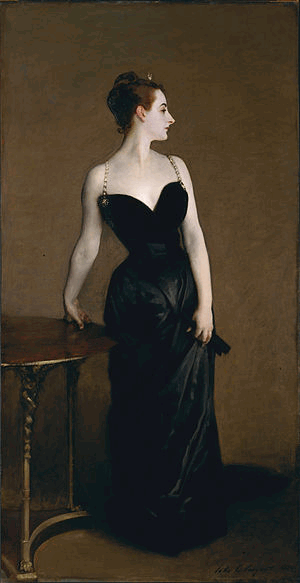|
Today in New Orleans History |
|
|
July 25


 To receive an update for each day in New Orleans history,
join our facebook page - Today in New
Orleans History.
Madame X Dies Virginie Amélie Avegno was born in New Orleans on January 29, 1859, the daughter of Anatole
Placide Avegno (July 3, 1835 – April 1862) and Marie Virginie de Ternant, of Parlange Plantation. She had a sister,
Valentine, who died of yellow fever. Her parents were white Creoles; her father was the son of Philippe Avegno (Italian) and
Catherine Genois. Her mother was a descendant of French nobility. Her father served as a major in the
Confederate Army during the Civil War; he died in 1862 in the Battle of Shiloh. He was the commander of the Avegno Zouaves
of New Orleans, a cosmopolitan battalion which had soldiers from a wide variety of ethnic backgrounds including French, Spanish,
Mexican, Irish, Italian, Chinese, German, Dutch, and Filipino soldiers. In 1867, when Virginia was eight,
her widowed mother moved with her to France. The girl was educated in Paris and introduced to high French society. Virginie
Avegno became one of Paris' conspicuous beauties, as she was a pale-skinned brunette with fine, cameo-like features and an
hourglass figure. She was known to use lavender-colored face and body powder to enhance her complexion, to dye her hair with
henna, and to color her eyebrows. She attracted much admiration due to her elegance and style. She married
Pierre Gautreau, a French banker and shipping magnate. She had a daughter named Louise Gautreau (1879-1911). She was rumored
to have had numerous affairs. She posed for paintings by several noted 19th-century painters, including
Gustave Courtois and Antonio de La Gandara. Most famously, she was the model for John Singer Sargent's
Portrait of Madame X. The painting created a cultural scandal when it was exhibited in 1884 at the Paris Salon. The suggestiveness
of the portrait and the style of clothing were considered scandalous, as well as publicizing Gautreau's reputation. Such a
high-class woman would not usually be a model. The scandal caused Gautreau to retire for some time from society. Antonio
de La Gandara painted a full-length portrait of her, entitled Madame Gautreau (1898). In tonality of colors, privacy of her
face, and style of her dress, it was more conservative than Sargent's painting. Gautreau died in Cannes
on July 25, 1915. She was buried in the Gautreau family crypt at their Chateau des Chênes in Saint-Malo, Brittany.
(Wiki)  To receive an update for each day in New Orleans
history, join our facebook page
- Today in New Orleans History
William Joseph "Billy" Guste, Jr. (May 26, 1922 – July 25, 2013), was
a New Orleans attorney, businessman and Democratic attorney general of Louisiana from 1972 to 1992. He succeeded Jack P.F.
Gremillion, a fellow Democrat engulfed in scandal who had held the position since 1956. Guste received recognition for molding
the office into a model of integrity and efficiency. In 1976, he helped Jimmy Carter, the former governor of Georgia, carry
Louisiana and served as the first elector listed on the ballot for the Carter-Mondale slate. With his brother, Roy Francis
Guste, Sr., William Guste was a fourth-generation proprietor of Antoine's Restaurant(Wiki) William George Helis, Sr., born on October 17, 1886, was an impoverished Greek emigrant to the United
States who made a fortune in the oil business and became a major owner/breeder of thoroughbred racehorses and a racetrack
owner. In his obituary, the Pittsburg Press called William Helis "one of the amazing figures of the American oilfields."
A resident with legal domicile in New Orleans, he died in Johns Hopkins Hospital in Baltimore on July 25, 1950.
His remains were brought home to New Orleans where he was interred in the Metairie Cemetery. His mausoleum was built
by American architect and sculptor, Albert Weiblen. In 1991, William Helis was posthumously inducted into the Fair Grounds
Racing Hall of Fame). Steven Benjamin Goodman (July 25, 1948 – September 20, 1984) — known as Steve
Goodman — was an American folk music singer-songwriter from Chicago, Illinois. Goodman was diagnosed with leukemia while
attending college, and he set out to make the most of the time he had left to write music. A prolific writer, Goodman is best
known for penning "City of New Orleans," a song made popular by Arlo Guthrie and Willie Nelson, for which Goodman
won his first Grammy Award posthumously in 1985. (Wiki)
Born in New Orleans on July 25, 1899, musician Johnny Wiggs (Born John Wigginton
Hyman) started his music career on the violin, then the cornet. In the late 1920s he took a job as a teacher, adopted
the stage name "Johnny Wiggs), and moonlighted in New Orleans jazz clubs at night. He made his first recordings as "John
Hyman's Bayou Stompers" in the late 1920s. In the 1940s he quit teaching (after having trained a young Pete Fountain),
led several bands, made some recordings, and became an an important figure in the revival and preservation of the local music
by founding the New Orleans Jazz Club. Hyman remained active until the 1970s. He passed away on in New Orleans
on October 10, 1977.
|
|
|

To receive an update for each day in New Orleans history,
join our facebook page - Today in New
Orleans History.
Analytics |


